Planning of Geographical Inquiry: Case Study Penrith Scheme
VerifiedAdded on 2023/06/05
|12
|2367
|136
AI Summary
This study investigates the Penrith Lakes Scheme as a contemporary geographical land utility or issue of land use. It examines the relationship between the place and the people in it, sustainability considerations, and the role of the government in the entire issue. The study involves group work, hands-on activities, and data collection from the site. The expected outcome is to describe different features and properties of places and environment, explain connections and interaction that exist between people, environment, and other places, compare and possibly contrast the effects on the management and organization of the environment and places, and process and communicate acquired geographical information through the use of proper tools of inquiry.
Contribute Materials
Your contribution can guide someone’s learning journey. Share your
documents today.
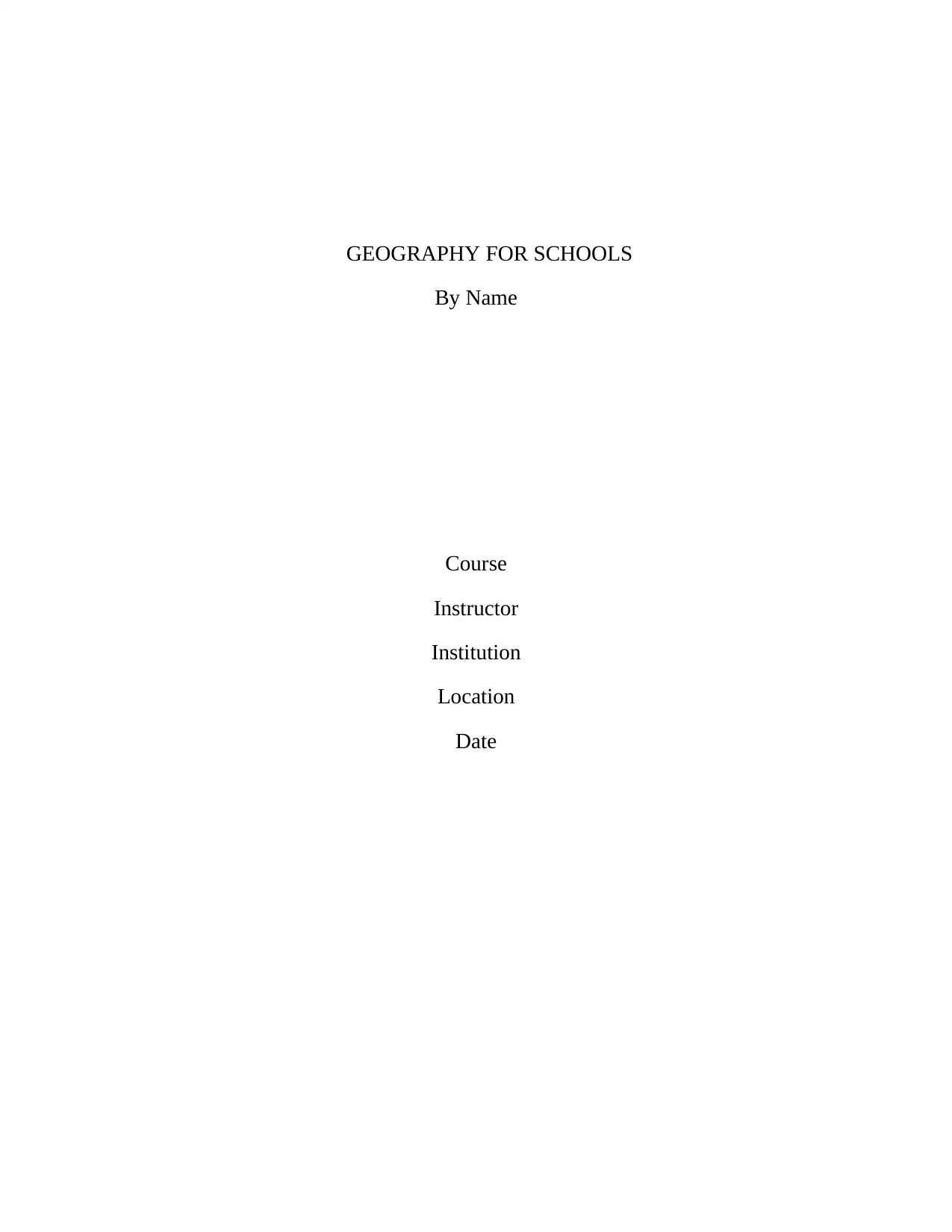
GEOGRAPHY FOR SCHOOLS
By Name
Course
Instructor
Institution
Location
Date
By Name
Course
Instructor
Institution
Location
Date
Secure Best Marks with AI Grader
Need help grading? Try our AI Grader for instant feedback on your assignments.
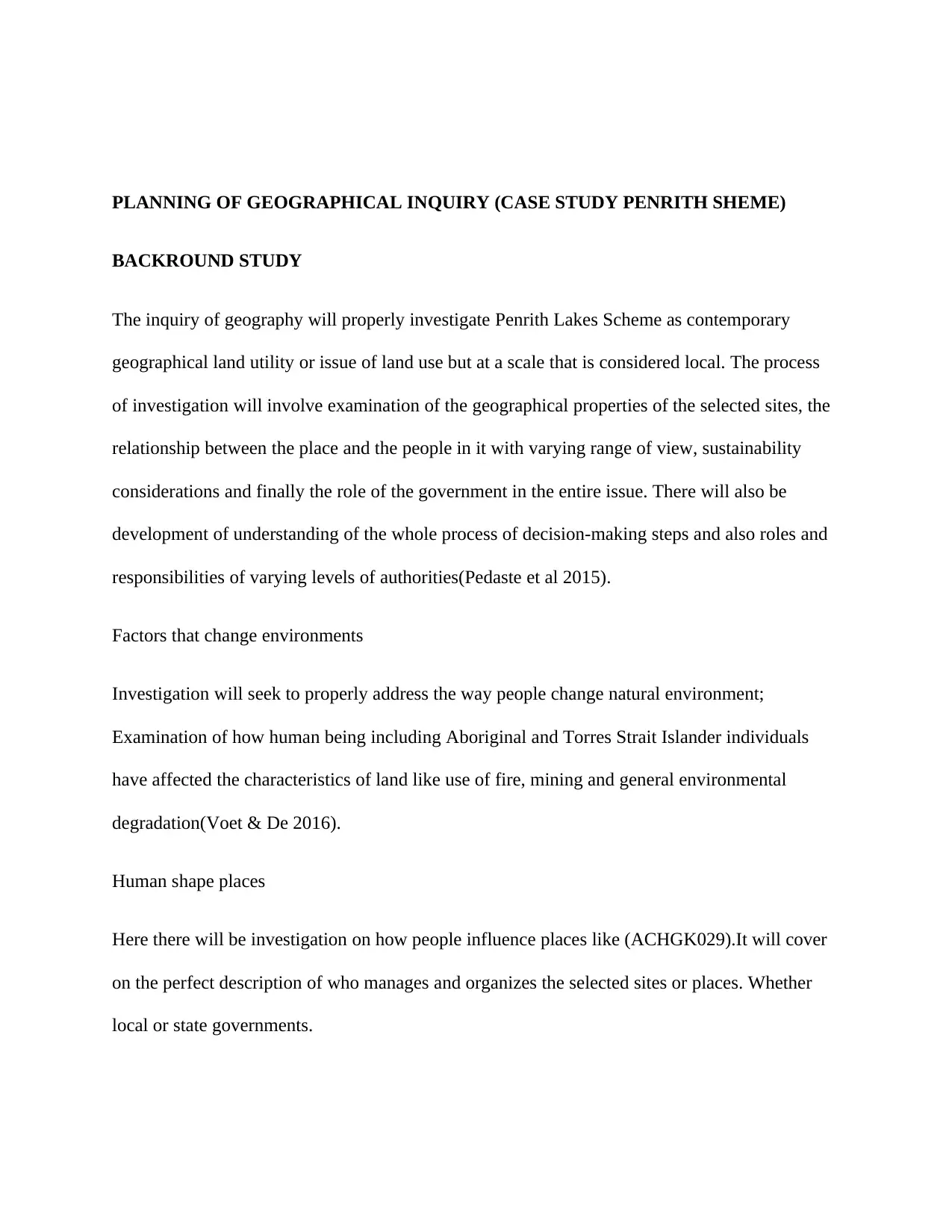
PLANNING OF GEOGRAPHICAL INQUIRY (CASE STUDY PENRITH SHEME)
BACKROUND STUDY
The inquiry of geography will properly investigate Penrith Lakes Scheme as contemporary
geographical land utility or issue of land use but at a scale that is considered local. The process
of investigation will involve examination of the geographical properties of the selected sites, the
relationship between the place and the people in it with varying range of view, sustainability
considerations and finally the role of the government in the entire issue. There will also be
development of understanding of the whole process of decision-making steps and also roles and
responsibilities of varying levels of authorities(Pedaste et al 2015).
Factors that change environments
Investigation will seek to properly address the way people change natural environment;
Examination of how human being including Aboriginal and Torres Strait Islander individuals
have affected the characteristics of land like use of fire, mining and general environmental
degradation(Voet & De 2016).
Human shape places
Here there will be investigation on how people influence places like (ACHGK029).It will cover
on the perfect description of who manages and organizes the selected sites or places. Whether
local or state governments.
BACKROUND STUDY
The inquiry of geography will properly investigate Penrith Lakes Scheme as contemporary
geographical land utility or issue of land use but at a scale that is considered local. The process
of investigation will involve examination of the geographical properties of the selected sites, the
relationship between the place and the people in it with varying range of view, sustainability
considerations and finally the role of the government in the entire issue. There will also be
development of understanding of the whole process of decision-making steps and also roles and
responsibilities of varying levels of authorities(Pedaste et al 2015).
Factors that change environments
Investigation will seek to properly address the way people change natural environment;
Examination of how human being including Aboriginal and Torres Strait Islander individuals
have affected the characteristics of land like use of fire, mining and general environmental
degradation(Voet & De 2016).
Human shape places
Here there will be investigation on how people influence places like (ACHGK029).It will cover
on the perfect description of who manages and organizes the selected sites or places. Whether
local or state governments.
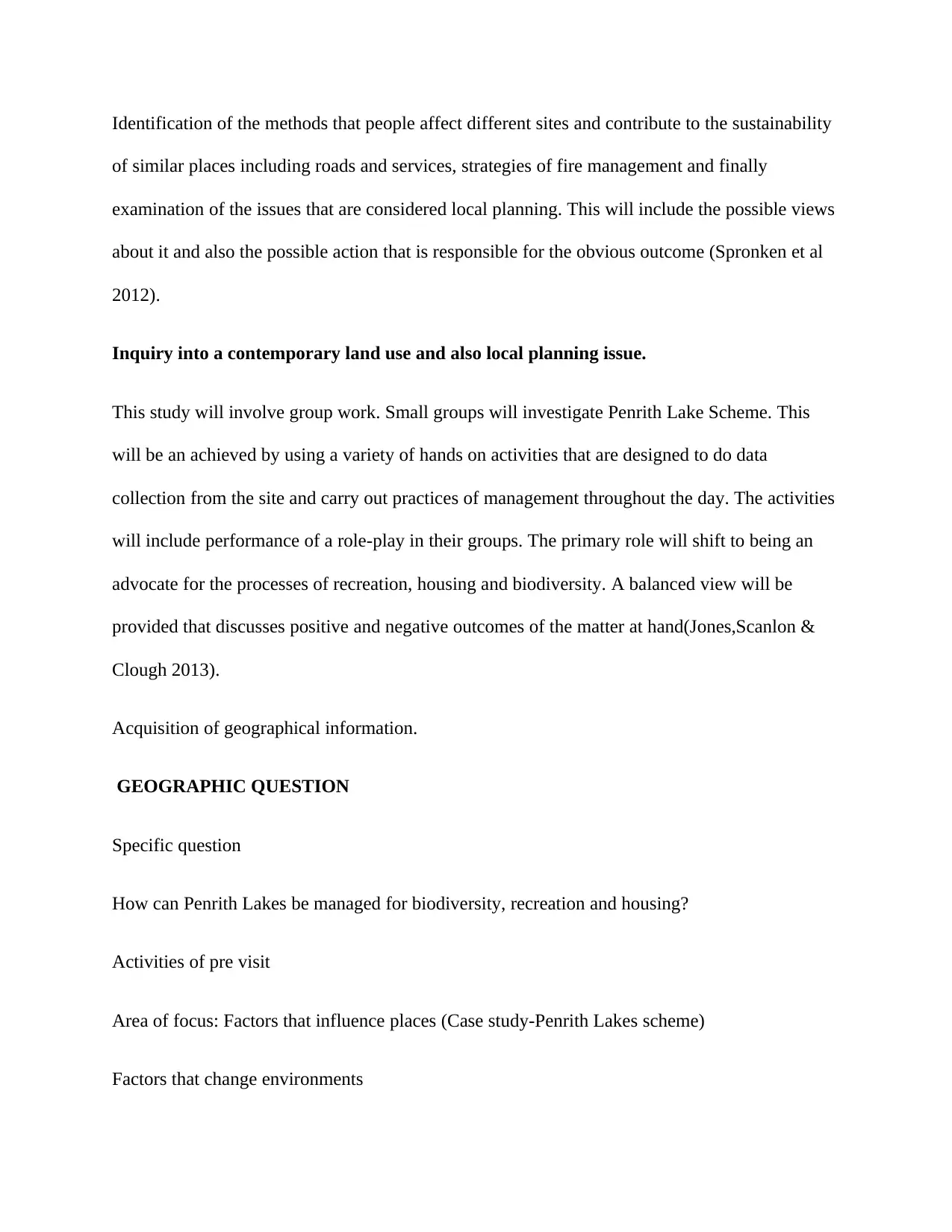
Identification of the methods that people affect different sites and contribute to the sustainability
of similar places including roads and services, strategies of fire management and finally
examination of the issues that are considered local planning. This will include the possible views
about it and also the possible action that is responsible for the obvious outcome (Spronken et al
2012).
Inquiry into a contemporary land use and also local planning issue.
This study will involve group work. Small groups will investigate Penrith Lake Scheme. This
will be an achieved by using a variety of hands on activities that are designed to do data
collection from the site and carry out practices of management throughout the day. The activities
will include performance of a role-play in their groups. The primary role will shift to being an
advocate for the processes of recreation, housing and biodiversity. A balanced view will be
provided that discusses positive and negative outcomes of the matter at hand(Jones,Scanlon &
Clough 2013).
Acquisition of geographical information.
GEOGRAPHIC QUESTION
Specific question
How can Penrith Lakes be managed for biodiversity, recreation and housing?
Activities of pre visit
Area of focus: Factors that influence places (Case study-Penrith Lakes scheme)
Factors that change environments
of similar places including roads and services, strategies of fire management and finally
examination of the issues that are considered local planning. This will include the possible views
about it and also the possible action that is responsible for the obvious outcome (Spronken et al
2012).
Inquiry into a contemporary land use and also local planning issue.
This study will involve group work. Small groups will investigate Penrith Lake Scheme. This
will be an achieved by using a variety of hands on activities that are designed to do data
collection from the site and carry out practices of management throughout the day. The activities
will include performance of a role-play in their groups. The primary role will shift to being an
advocate for the processes of recreation, housing and biodiversity. A balanced view will be
provided that discusses positive and negative outcomes of the matter at hand(Jones,Scanlon &
Clough 2013).
Acquisition of geographical information.
GEOGRAPHIC QUESTION
Specific question
How can Penrith Lakes be managed for biodiversity, recreation and housing?
Activities of pre visit
Area of focus: Factors that influence places (Case study-Penrith Lakes scheme)
Factors that change environments
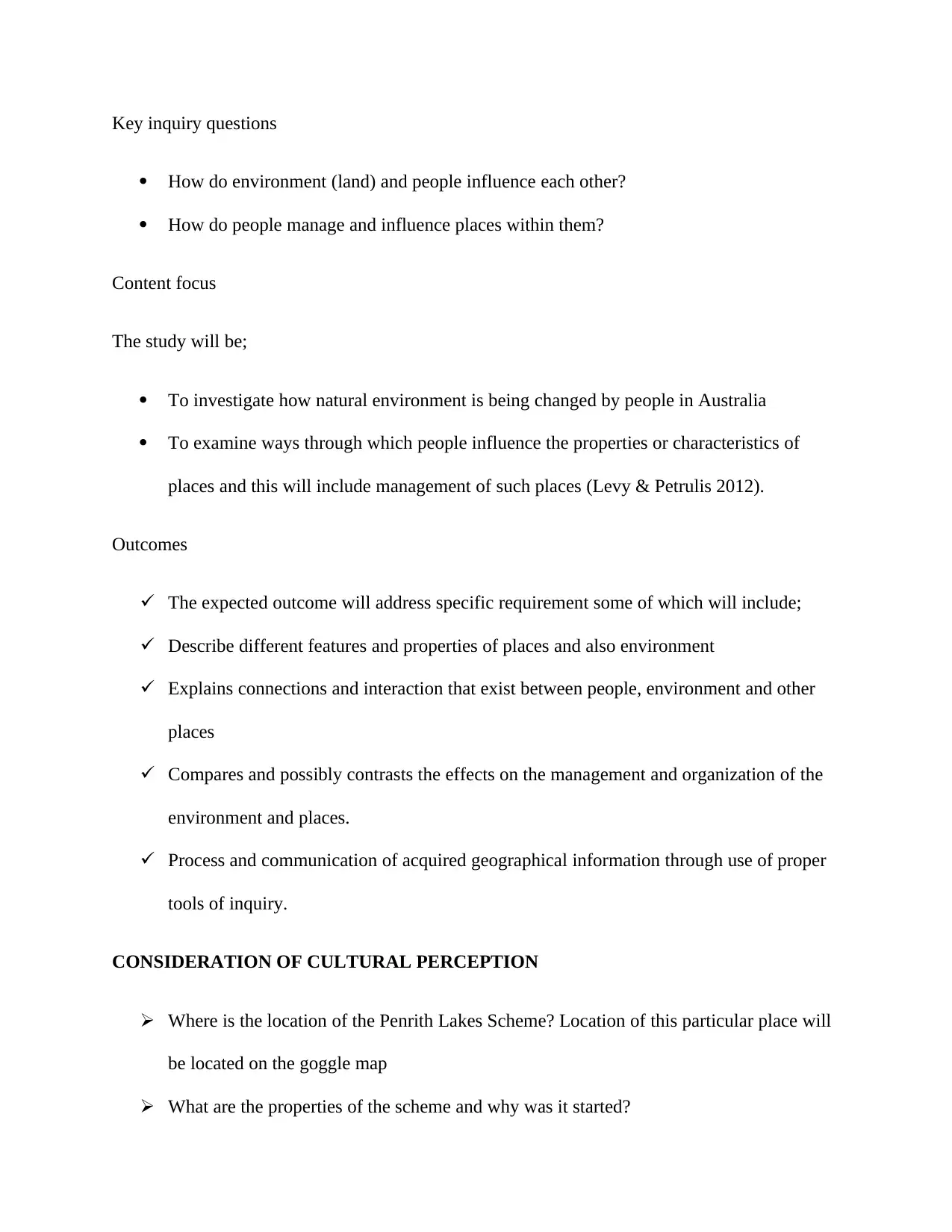
Key inquiry questions
How do environment (land) and people influence each other?
How do people manage and influence places within them?
Content focus
The study will be;
To investigate how natural environment is being changed by people in Australia
To examine ways through which people influence the properties or characteristics of
places and this will include management of such places (Levy & Petrulis 2012).
Outcomes
The expected outcome will address specific requirement some of which will include;
Describe different features and properties of places and also environment
Explains connections and interaction that exist between people, environment and other
places
Compares and possibly contrasts the effects on the management and organization of the
environment and places.
Process and communication of acquired geographical information through use of proper
tools of inquiry.
CONSIDERATION OF CULTURAL PERCEPTION
Where is the location of the Penrith Lakes Scheme? Location of this particular place will
be located on the goggle map
What are the properties of the scheme and why was it started?
How do environment (land) and people influence each other?
How do people manage and influence places within them?
Content focus
The study will be;
To investigate how natural environment is being changed by people in Australia
To examine ways through which people influence the properties or characteristics of
places and this will include management of such places (Levy & Petrulis 2012).
Outcomes
The expected outcome will address specific requirement some of which will include;
Describe different features and properties of places and also environment
Explains connections and interaction that exist between people, environment and other
places
Compares and possibly contrasts the effects on the management and organization of the
environment and places.
Process and communication of acquired geographical information through use of proper
tools of inquiry.
CONSIDERATION OF CULTURAL PERCEPTION
Where is the location of the Penrith Lakes Scheme? Location of this particular place will
be located on the goggle map
What are the properties of the scheme and why was it started?
Secure Best Marks with AI Grader
Need help grading? Try our AI Grader for instant feedback on your assignments.
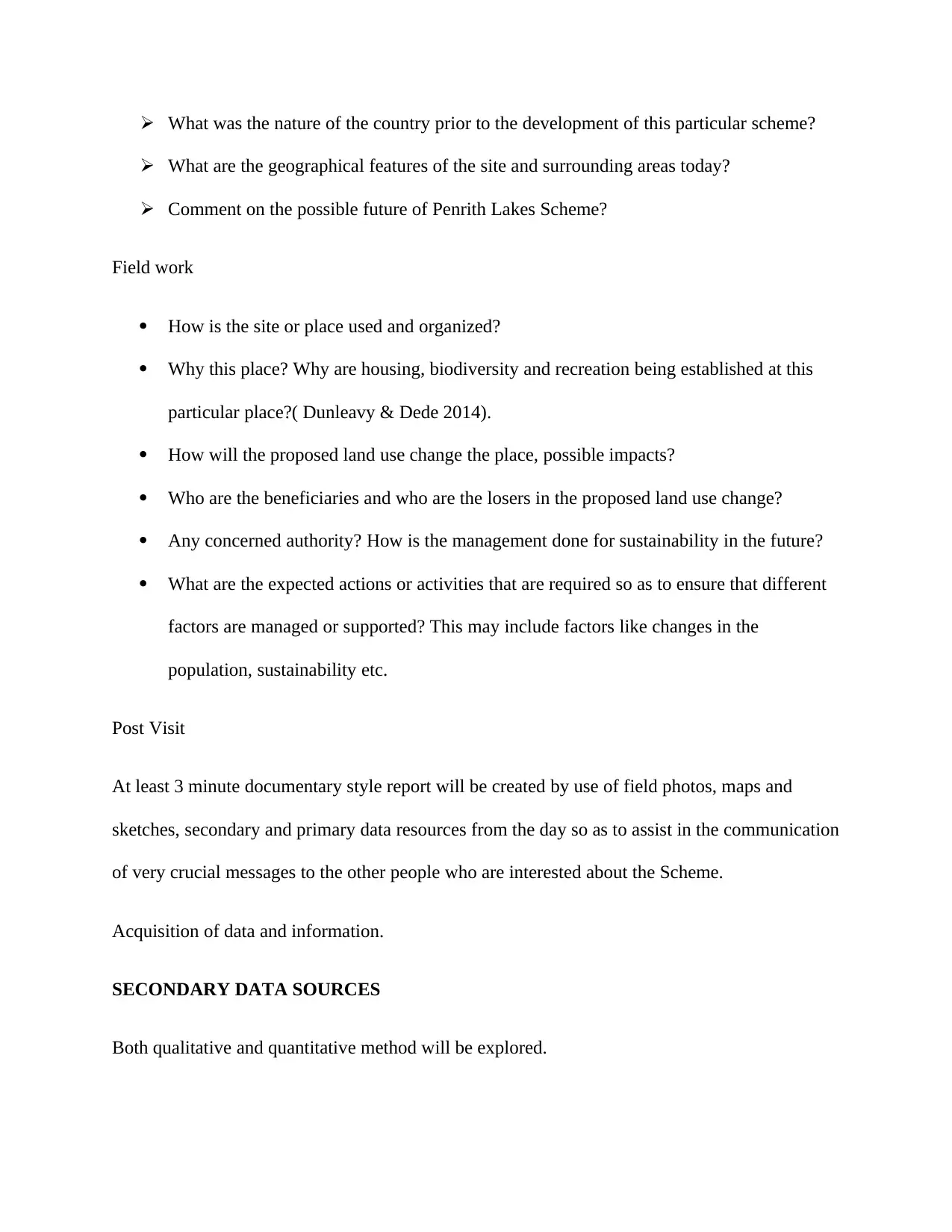
What was the nature of the country prior to the development of this particular scheme?
What are the geographical features of the site and surrounding areas today?
Comment on the possible future of Penrith Lakes Scheme?
Field work
How is the site or place used and organized?
Why this place? Why are housing, biodiversity and recreation being established at this
particular place?( Dunleavy & Dede 2014).
How will the proposed land use change the place, possible impacts?
Who are the beneficiaries and who are the losers in the proposed land use change?
Any concerned authority? How is the management done for sustainability in the future?
What are the expected actions or activities that are required so as to ensure that different
factors are managed or supported? This may include factors like changes in the
population, sustainability etc.
Post Visit
At least 3 minute documentary style report will be created by use of field photos, maps and
sketches, secondary and primary data resources from the day so as to assist in the communication
of very crucial messages to the other people who are interested about the Scheme.
Acquisition of data and information.
SECONDARY DATA SOURCES
Both qualitative and quantitative method will be explored.
What are the geographical features of the site and surrounding areas today?
Comment on the possible future of Penrith Lakes Scheme?
Field work
How is the site or place used and organized?
Why this place? Why are housing, biodiversity and recreation being established at this
particular place?( Dunleavy & Dede 2014).
How will the proposed land use change the place, possible impacts?
Who are the beneficiaries and who are the losers in the proposed land use change?
Any concerned authority? How is the management done for sustainability in the future?
What are the expected actions or activities that are required so as to ensure that different
factors are managed or supported? This may include factors like changes in the
population, sustainability etc.
Post Visit
At least 3 minute documentary style report will be created by use of field photos, maps and
sketches, secondary and primary data resources from the day so as to assist in the communication
of very crucial messages to the other people who are interested about the Scheme.
Acquisition of data and information.
SECONDARY DATA SOURCES
Both qualitative and quantitative method will be explored.
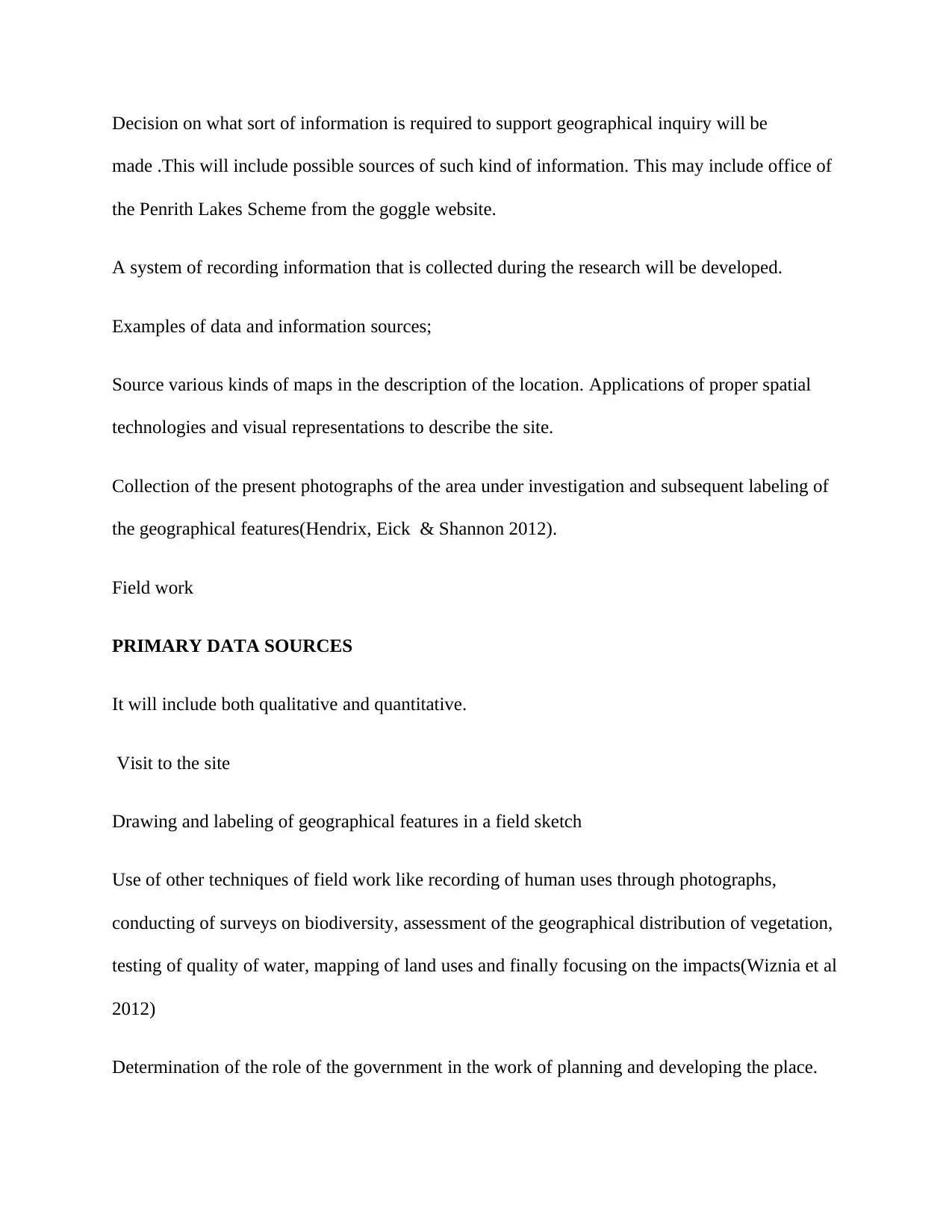
Decision on what sort of information is required to support geographical inquiry will be
made .This will include possible sources of such kind of information. This may include office of
the Penrith Lakes Scheme from the goggle website.
A system of recording information that is collected during the research will be developed.
Examples of data and information sources;
Source various kinds of maps in the description of the location. Applications of proper spatial
technologies and visual representations to describe the site.
Collection of the present photographs of the area under investigation and subsequent labeling of
the geographical features(Hendrix, Eick & Shannon 2012).
Field work
PRIMARY DATA SOURCES
It will include both qualitative and quantitative.
Visit to the site
Drawing and labeling of geographical features in a field sketch
Use of other techniques of field work like recording of human uses through photographs,
conducting of surveys on biodiversity, assessment of the geographical distribution of vegetation,
testing of quality of water, mapping of land uses and finally focusing on the impacts(Wiznia et al
2012)
Determination of the role of the government in the work of planning and developing the place.
made .This will include possible sources of such kind of information. This may include office of
the Penrith Lakes Scheme from the goggle website.
A system of recording information that is collected during the research will be developed.
Examples of data and information sources;
Source various kinds of maps in the description of the location. Applications of proper spatial
technologies and visual representations to describe the site.
Collection of the present photographs of the area under investigation and subsequent labeling of
the geographical features(Hendrix, Eick & Shannon 2012).
Field work
PRIMARY DATA SOURCES
It will include both qualitative and quantitative.
Visit to the site
Drawing and labeling of geographical features in a field sketch
Use of other techniques of field work like recording of human uses through photographs,
conducting of surveys on biodiversity, assessment of the geographical distribution of vegetation,
testing of quality of water, mapping of land uses and finally focusing on the impacts(Wiznia et al
2012)
Determination of the role of the government in the work of planning and developing the place.
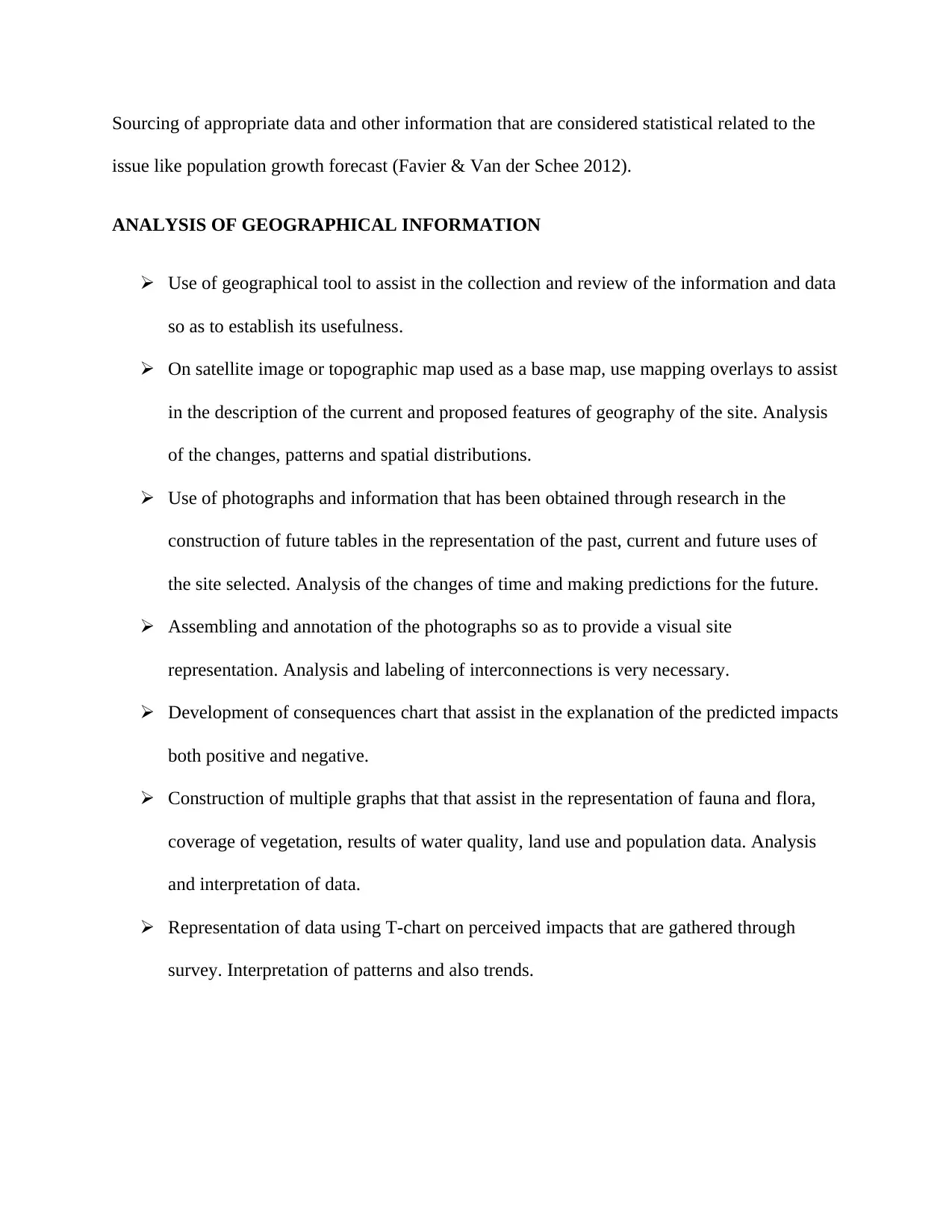
Sourcing of appropriate data and other information that are considered statistical related to the
issue like population growth forecast (Favier & Van der Schee 2012).
ANALYSIS OF GEOGRAPHICAL INFORMATION
Use of geographical tool to assist in the collection and review of the information and data
so as to establish its usefulness.
On satellite image or topographic map used as a base map, use mapping overlays to assist
in the description of the current and proposed features of geography of the site. Analysis
of the changes, patterns and spatial distributions.
Use of photographs and information that has been obtained through research in the
construction of future tables in the representation of the past, current and future uses of
the site selected. Analysis of the changes of time and making predictions for the future.
Assembling and annotation of the photographs so as to provide a visual site
representation. Analysis and labeling of interconnections is very necessary.
Development of consequences chart that assist in the explanation of the predicted impacts
both positive and negative.
Construction of multiple graphs that that assist in the representation of fauna and flora,
coverage of vegetation, results of water quality, land use and population data. Analysis
and interpretation of data.
Representation of data using T-chart on perceived impacts that are gathered through
survey. Interpretation of patterns and also trends.
issue like population growth forecast (Favier & Van der Schee 2012).
ANALYSIS OF GEOGRAPHICAL INFORMATION
Use of geographical tool to assist in the collection and review of the information and data
so as to establish its usefulness.
On satellite image or topographic map used as a base map, use mapping overlays to assist
in the description of the current and proposed features of geography of the site. Analysis
of the changes, patterns and spatial distributions.
Use of photographs and information that has been obtained through research in the
construction of future tables in the representation of the past, current and future uses of
the site selected. Analysis of the changes of time and making predictions for the future.
Assembling and annotation of the photographs so as to provide a visual site
representation. Analysis and labeling of interconnections is very necessary.
Development of consequences chart that assist in the explanation of the predicted impacts
both positive and negative.
Construction of multiple graphs that that assist in the representation of fauna and flora,
coverage of vegetation, results of water quality, land use and population data. Analysis
and interpretation of data.
Representation of data using T-chart on perceived impacts that are gathered through
survey. Interpretation of patterns and also trends.
Paraphrase This Document
Need a fresh take? Get an instant paraphrase of this document with our AI Paraphraser
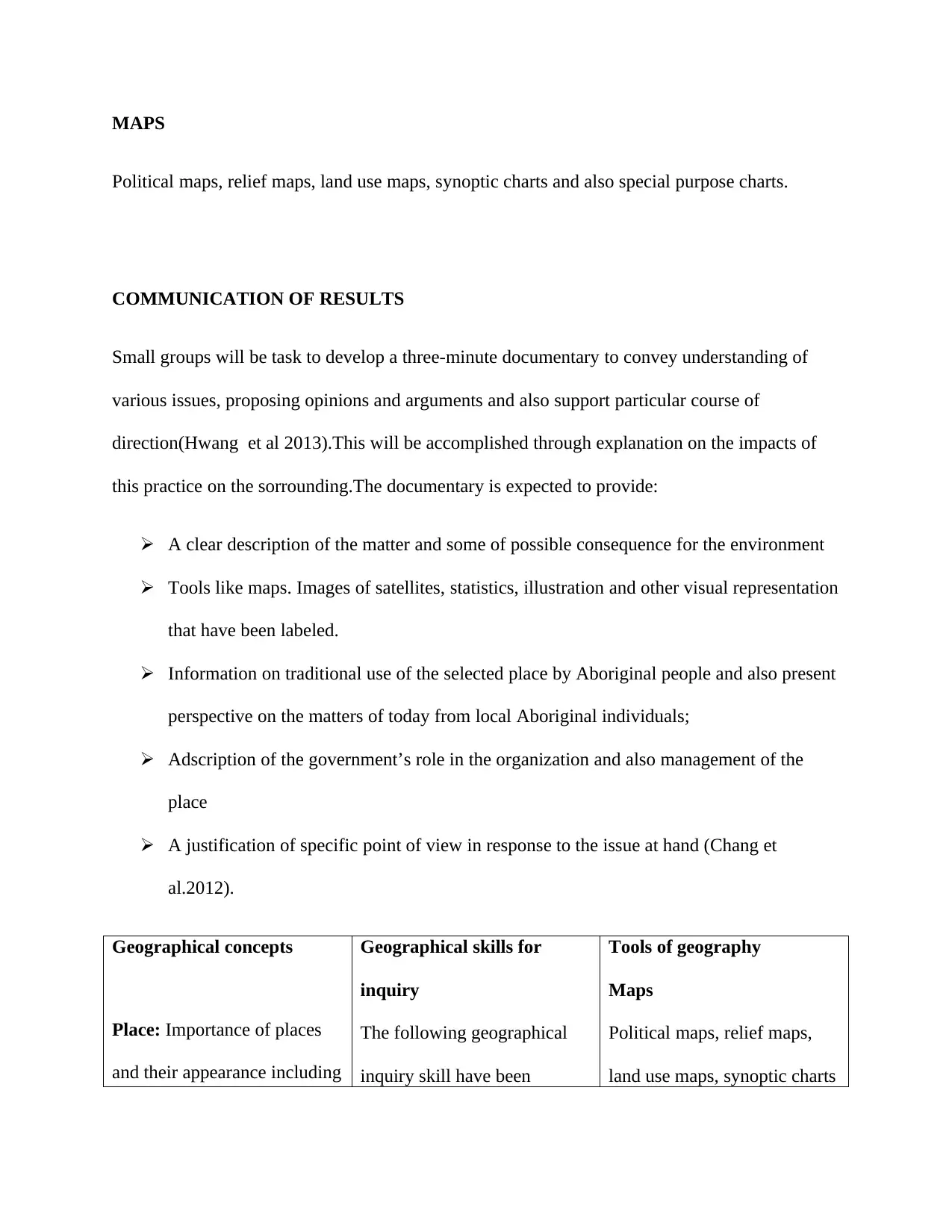
MAPS
Political maps, relief maps, land use maps, synoptic charts and also special purpose charts.
COMMUNICATION OF RESULTS
Small groups will be task to develop a three-minute documentary to convey understanding of
various issues, proposing opinions and arguments and also support particular course of
direction(Hwang et al 2013).This will be accomplished through explanation on the impacts of
this practice on the sorrounding.The documentary is expected to provide:
A clear description of the matter and some of possible consequence for the environment
Tools like maps. Images of satellites, statistics, illustration and other visual representation
that have been labeled.
Information on traditional use of the selected place by Aboriginal people and also present
perspective on the matters of today from local Aboriginal individuals;
Adscription of the government’s role in the organization and also management of the
place
A justification of specific point of view in response to the issue at hand (Chang et
al.2012).
Geographical concepts
Place: Importance of places
and their appearance including
Geographical skills for
inquiry
The following geographical
inquiry skill have been
Tools of geography
Maps
Political maps, relief maps,
land use maps, synoptic charts
Political maps, relief maps, land use maps, synoptic charts and also special purpose charts.
COMMUNICATION OF RESULTS
Small groups will be task to develop a three-minute documentary to convey understanding of
various issues, proposing opinions and arguments and also support particular course of
direction(Hwang et al 2013).This will be accomplished through explanation on the impacts of
this practice on the sorrounding.The documentary is expected to provide:
A clear description of the matter and some of possible consequence for the environment
Tools like maps. Images of satellites, statistics, illustration and other visual representation
that have been labeled.
Information on traditional use of the selected place by Aboriginal people and also present
perspective on the matters of today from local Aboriginal individuals;
Adscription of the government’s role in the organization and also management of the
place
A justification of specific point of view in response to the issue at hand (Chang et
al.2012).
Geographical concepts
Place: Importance of places
and their appearance including
Geographical skills for
inquiry
The following geographical
inquiry skill have been
Tools of geography
Maps
Political maps, relief maps,
land use maps, synoptic charts
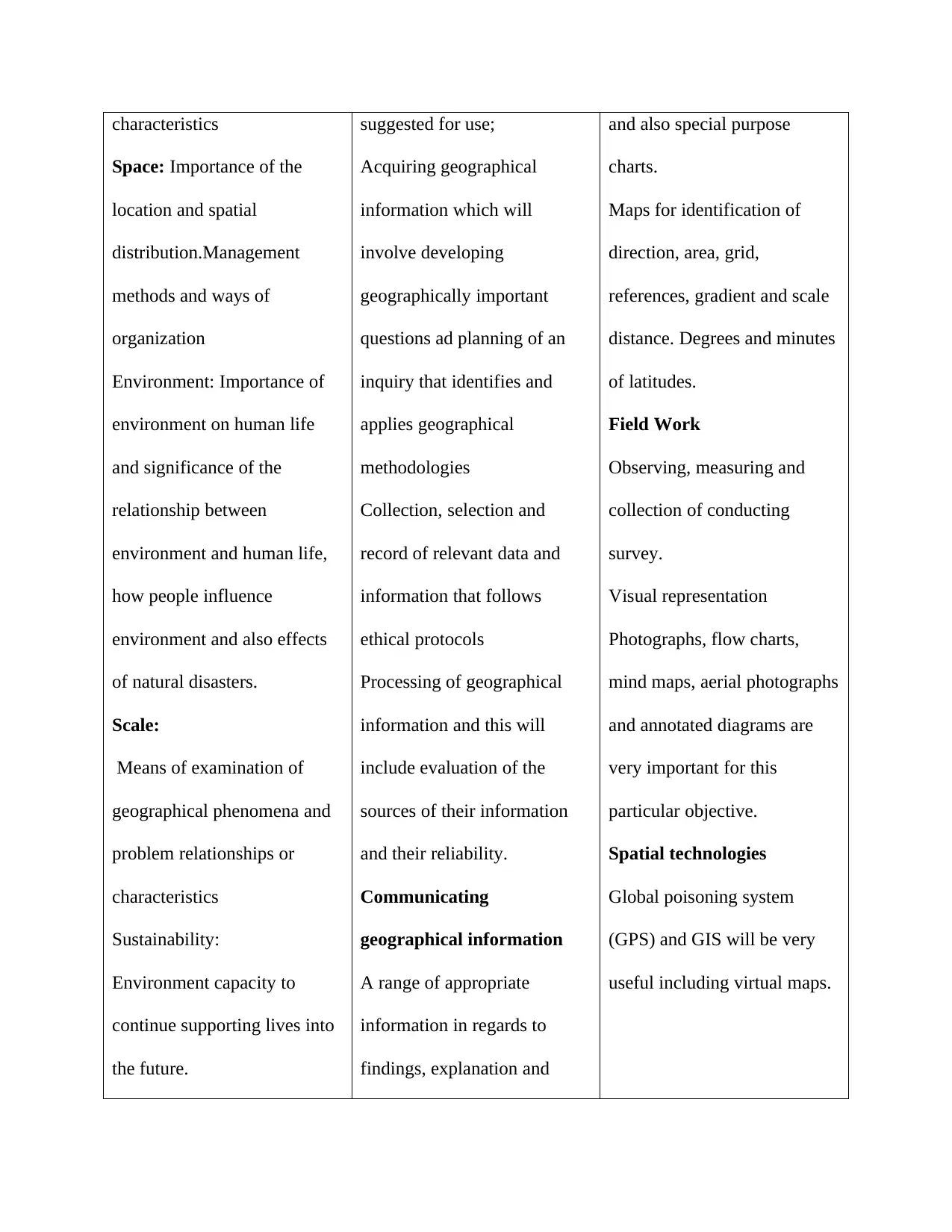
characteristics
Space: Importance of the
location and spatial
distribution.Management
methods and ways of
organization
Environment: Importance of
environment on human life
and significance of the
relationship between
environment and human life,
how people influence
environment and also effects
of natural disasters.
Scale:
Means of examination of
geographical phenomena and
problem relationships or
characteristics
Sustainability:
Environment capacity to
continue supporting lives into
the future.
suggested for use;
Acquiring geographical
information which will
involve developing
geographically important
questions ad planning of an
inquiry that identifies and
applies geographical
methodologies
Collection, selection and
record of relevant data and
information that follows
ethical protocols
Processing of geographical
information and this will
include evaluation of the
sources of their information
and their reliability.
Communicating
geographical information
A range of appropriate
information in regards to
findings, explanation and
and also special purpose
charts.
Maps for identification of
direction, area, grid,
references, gradient and scale
distance. Degrees and minutes
of latitudes.
Field Work
Observing, measuring and
collection of conducting
survey.
Visual representation
Photographs, flow charts,
mind maps, aerial photographs
and annotated diagrams are
very important for this
particular objective.
Spatial technologies
Global poisoning system
(GPS) and GIS will be very
useful including virtual maps.
Space: Importance of the
location and spatial
distribution.Management
methods and ways of
organization
Environment: Importance of
environment on human life
and significance of the
relationship between
environment and human life,
how people influence
environment and also effects
of natural disasters.
Scale:
Means of examination of
geographical phenomena and
problem relationships or
characteristics
Sustainability:
Environment capacity to
continue supporting lives into
the future.
suggested for use;
Acquiring geographical
information which will
involve developing
geographically important
questions ad planning of an
inquiry that identifies and
applies geographical
methodologies
Collection, selection and
record of relevant data and
information that follows
ethical protocols
Processing of geographical
information and this will
include evaluation of the
sources of their information
and their reliability.
Communicating
geographical information
A range of appropriate
information in regards to
findings, explanation and
and also special purpose
charts.
Maps for identification of
direction, area, grid,
references, gradient and scale
distance. Degrees and minutes
of latitudes.
Field Work
Observing, measuring and
collection of conducting
survey.
Visual representation
Photographs, flow charts,
mind maps, aerial photographs
and annotated diagrams are
very important for this
particular objective.
Spatial technologies
Global poisoning system
(GPS) and GIS will be very
useful including virtual maps.

Change:
Explanation of geographical
features based on how they
have developed with time.
arguments that are considered
effective will be considered.
Also relevant geographical
terminologies will be used.
Reflection and evaluation of
the findings of every inquiry
that puts into account
environmental, social and
economic factors.
Explanation of geographical
features based on how they
have developed with time.
arguments that are considered
effective will be considered.
Also relevant geographical
terminologies will be used.
Reflection and evaluation of
the findings of every inquiry
that puts into account
environmental, social and
economic factors.
Secure Best Marks with AI Grader
Need help grading? Try our AI Grader for instant feedback on your assignments.
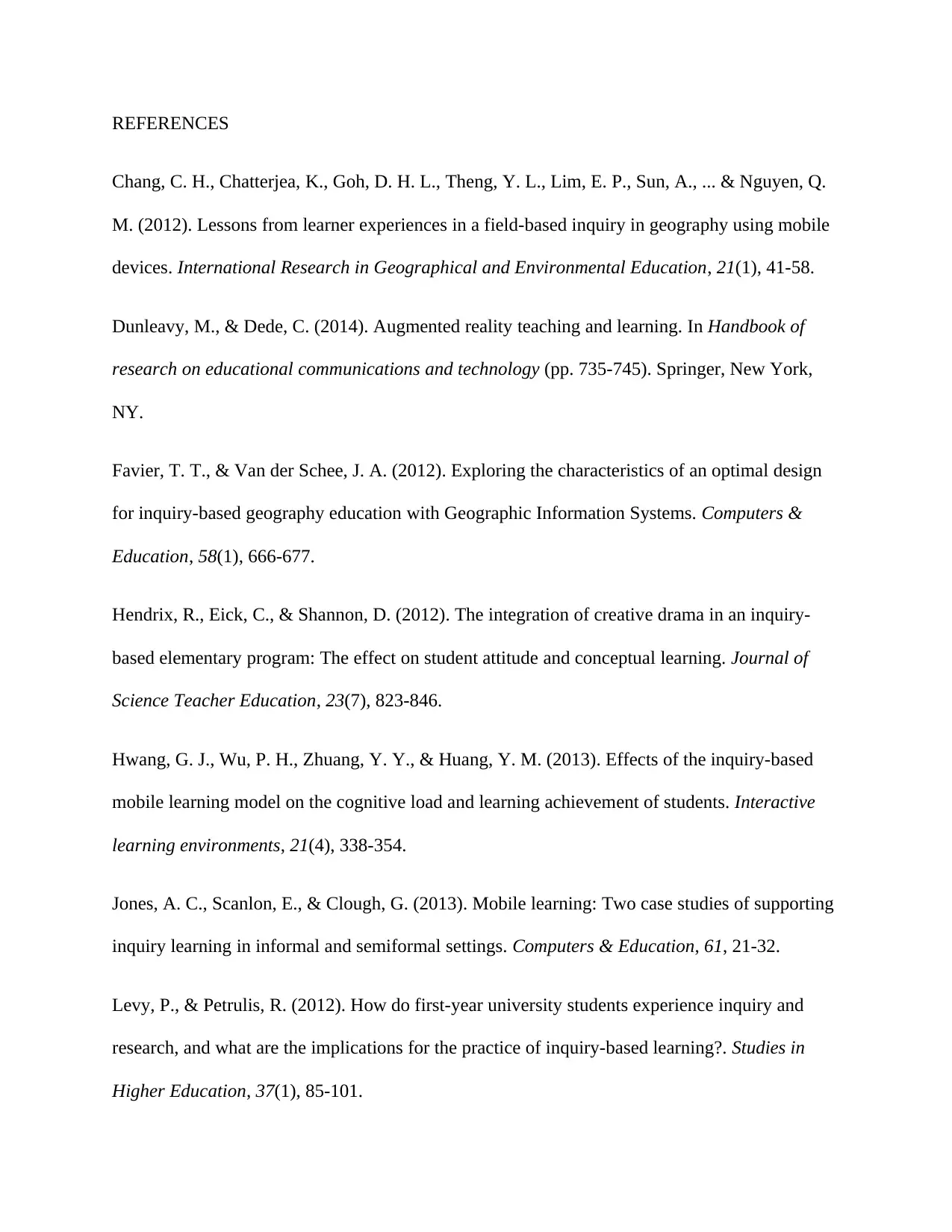
REFERENCES
Chang, C. H., Chatterjea, K., Goh, D. H. L., Theng, Y. L., Lim, E. P., Sun, A., ... & Nguyen, Q.
M. (2012). Lessons from learner experiences in a field-based inquiry in geography using mobile
devices. International Research in Geographical and Environmental Education, 21(1), 41-58.
Dunleavy, M., & Dede, C. (2014). Augmented reality teaching and learning. In Handbook of
research on educational communications and technology (pp. 735-745). Springer, New York,
NY.
Favier, T. T., & Van der Schee, J. A. (2012). Exploring the characteristics of an optimal design
for inquiry-based geography education with Geographic Information Systems. Computers &
Education, 58(1), 666-677.
Hendrix, R., Eick, C., & Shannon, D. (2012). The integration of creative drama in an inquiry-
based elementary program: The effect on student attitude and conceptual learning. Journal of
Science Teacher Education, 23(7), 823-846.
Hwang, G. J., Wu, P. H., Zhuang, Y. Y., & Huang, Y. M. (2013). Effects of the inquiry-based
mobile learning model on the cognitive load and learning achievement of students. Interactive
learning environments, 21(4), 338-354.
Jones, A. C., Scanlon, E., & Clough, G. (2013). Mobile learning: Two case studies of supporting
inquiry learning in informal and semiformal settings. Computers & Education, 61, 21-32.
Levy, P., & Petrulis, R. (2012). How do first-year university students experience inquiry and
research, and what are the implications for the practice of inquiry-based learning?. Studies in
Higher Education, 37(1), 85-101.
Chang, C. H., Chatterjea, K., Goh, D. H. L., Theng, Y. L., Lim, E. P., Sun, A., ... & Nguyen, Q.
M. (2012). Lessons from learner experiences in a field-based inquiry in geography using mobile
devices. International Research in Geographical and Environmental Education, 21(1), 41-58.
Dunleavy, M., & Dede, C. (2014). Augmented reality teaching and learning. In Handbook of
research on educational communications and technology (pp. 735-745). Springer, New York,
NY.
Favier, T. T., & Van der Schee, J. A. (2012). Exploring the characteristics of an optimal design
for inquiry-based geography education with Geographic Information Systems. Computers &
Education, 58(1), 666-677.
Hendrix, R., Eick, C., & Shannon, D. (2012). The integration of creative drama in an inquiry-
based elementary program: The effect on student attitude and conceptual learning. Journal of
Science Teacher Education, 23(7), 823-846.
Hwang, G. J., Wu, P. H., Zhuang, Y. Y., & Huang, Y. M. (2013). Effects of the inquiry-based
mobile learning model on the cognitive load and learning achievement of students. Interactive
learning environments, 21(4), 338-354.
Jones, A. C., Scanlon, E., & Clough, G. (2013). Mobile learning: Two case studies of supporting
inquiry learning in informal and semiformal settings. Computers & Education, 61, 21-32.
Levy, P., & Petrulis, R. (2012). How do first-year university students experience inquiry and
research, and what are the implications for the practice of inquiry-based learning?. Studies in
Higher Education, 37(1), 85-101.

Pedaste, M., Mäeots, M., Siiman, L. A., De Jong, T., Van Riesen, S. A., Kamp, E. T., ... &
Tsourlidaki, E. (2015). Phases of inquiry-based learning: Definitions and the inquiry
cycle. Educational research review, 14, 47-61.
Spronken-Smith, R., Walker, R., Batchelor, J., O’Steen, B., & Angelo, T. (2012). Evaluating
student perceptions of learning processes and intended learning outcomes under inquiry
approaches. Assessment & Evaluation in Higher Education, 37(1), 57-72.
Voet, M., & De Wever, B. (2016). History teachers' conceptions of inquiry-based learning,
beliefs about the nature of history, and their relation to the classroom context. Teaching and
Teacher Education, 55, 57-67.
Wiznia, D., Korom, R., Marzuk, P., Safdieh, J., & Grafstein, B. (2012). PBL 2.0: enhancing
problem-based learning through increased student participation. Medical education online, 17(1),
17375.
Tsourlidaki, E. (2015). Phases of inquiry-based learning: Definitions and the inquiry
cycle. Educational research review, 14, 47-61.
Spronken-Smith, R., Walker, R., Batchelor, J., O’Steen, B., & Angelo, T. (2012). Evaluating
student perceptions of learning processes and intended learning outcomes under inquiry
approaches. Assessment & Evaluation in Higher Education, 37(1), 57-72.
Voet, M., & De Wever, B. (2016). History teachers' conceptions of inquiry-based learning,
beliefs about the nature of history, and their relation to the classroom context. Teaching and
Teacher Education, 55, 57-67.
Wiznia, D., Korom, R., Marzuk, P., Safdieh, J., & Grafstein, B. (2012). PBL 2.0: enhancing
problem-based learning through increased student participation. Medical education online, 17(1),
17375.
1 out of 12
Your All-in-One AI-Powered Toolkit for Academic Success.
+13062052269
info@desklib.com
Available 24*7 on WhatsApp / Email
![[object Object]](/_next/static/media/star-bottom.7253800d.svg)
Unlock your academic potential
© 2024 | Zucol Services PVT LTD | All rights reserved.


